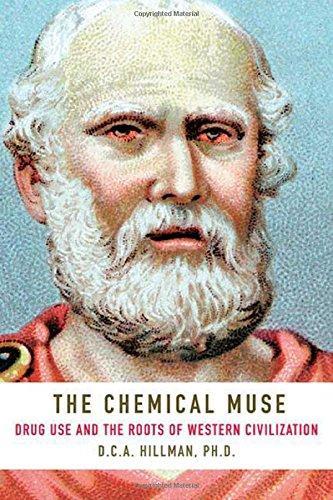Review of 'The Chemical Muse : Drug Use and the Roots of Western Civilization' on 'Goodreads'
3 stars
I stumbled upon this book by roundabout way. I’ve watched a documentary where D.C.A. Hillman was featured, and saw him labeled as the author of this Chemical Muse work on the drug use and the roots of western civilization.
For quite some time now, I’ve had this intuition (for lack of better word) that history classes were somewhat lacking in regards to acknowledging the role drugs played in whatever was happening back then. I got that feeling (stressing it was just a feeling, for I lack expertise on the subject) just by reading some of the works of the Greco-Roman period, since they seemed to hint that the author had had his mind altered in order to have the kind of view presented in his writing. Nevertheless, my intuition could easily be dismissed for lack of any expert view on the matter, so, if anything, this was just one of those things I kept on the back of my head for lack of further evidence.
And here is why finding this book struck me as such an interesting proposal. For here it was the expert’s opinion on this particular topic promising to dig up that forgotten (or hidden) aspect of our culture’s past. So I read it eager as I was to find out how the author would argue in favor of that thesis.
The book opens with a very engaging presentation of the main reason why Hillman chose to write this book. For those of you who have had college experience, his description of what happened during his doctoral cross examination in regard to his research findings concerning recreational drug use in Ancient Rome will not come as a surprise. He had to remove his findings from the overall work or his doctoral degree would be rejected. Having done so, he remedied the removal by publishing his findings in the form of this book.
And here is where things get interesting. I was expecting a different kind of approach; well, not that I had a particular map in mind, but what I mean is that Hillman’s approach surprised me positively. For he starts to describe how terrible and miserable was life back then in the ancient Greco-Roman world. Too much suffering, disease and death for those poor wretched people forsake plant medicines just for the sake of some abstruse morality. And it makes sense. Plants were needed for they provided at least some comfort and assurance where little to none was to find. That also meant that they stumbled upon the mind altering effects of those same plants. And knowing them, they surely used them. It makes more sense if you think as Hillman points out the way.
In the following chapters, the author continues to guide us through what amounts to a congruent view that the use of recreational drugs was not only a reality but a necessary one in the context of those living back then. Taking bits from different sources, Hillman mounts his case by showing that different authors in antiquity, both Greek and Roman, were not only familiar with the various aspects of the possible uses of medicinal plants, as they seem to hint they also knew by first-hand experience the recreational uses of those very same plants.
In one really interesting chapter, The Pharmacology of Western Philosophy, Hillman presents a good case stressing the importance of mind-altering substances in promoting the development of Greek philosophy in ancient Pre-Socratic times.
Overall, the book tries to speak with different people, with very different views and specialization concerning the subject of Greco-Roman civilization. On the one hand, Hillman is very critical of most Classicists stance in regard to the specific topic of drug use in antiquity; but on the other hand, he is also speaking to the larger public that may be open to understand the past through this new perspective.
In spite its many strengths, the book is a little short on hard evidence to support its case — that is, there are too few references to actual texts that could make a stronger case for those who are not convinced by his overarching argument. But that could easily be justified as this book is not intended to be a specialists book only. Instead of offering the passages, Hillman points to where one can find them, if one is so inclined to do so.
If, like me, you’re partial to this subject; that is, if you already are favorable to the view that drug use and human history go side by side wherever you look, you’ll find this book very enlightening and pleasing. But if you oppose this view, I’m not sure if you’ll find the whole argument compelling. Nonetheless, if you have in you some spark of curiosity to allow yourself a different understanding of what might have happened in the past, you probably will find this book very engaging.

